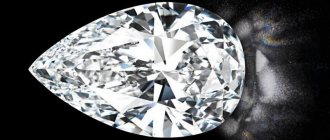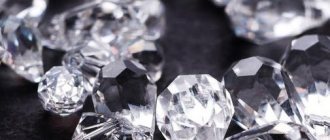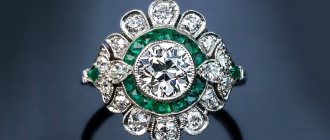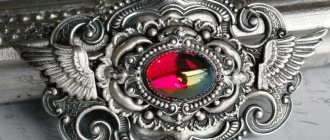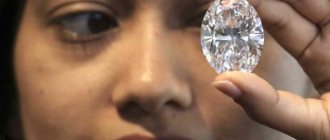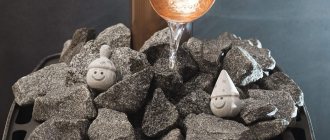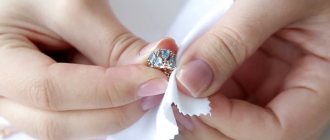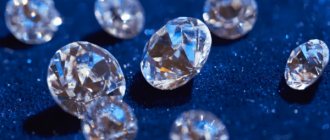Marilyn Monroe, Grace Kelly, Audrey Hepburn and Elizabeth Taylor - these women were united not only by the stage, but also by an endless love for diamonds. It is not surprising, because these rare stones are magically beautiful, the only thing that repels them is their cosmically high cost.
Together with the online jewelry store Bright Spark, Heroine has made a selection of luxurious, but affordable moissanite jewelry that looks no worse than the most famous diamonds in the world - Cullinan, Kohinoora or Alnatta.
Moissanite: what kind of stone is it, its history
Moissanite is a gem that was first created artificially and then discovered as natural stones in nature.
Moissanite single crystal ~1 mm in size
The history of synthetic moissanite begins in 1824, when chemist John Berzelius decided to create an analogue of diamond from silicon carbide. The idea was implemented by Edward Acheson in 1893. He designed a furnace and produced silicon carbide powder, patenting it as carborundum.
Moissonite of natural origin was first discovered in the remains of a meteorite that fell in the US state of Arizona. Ferdinand Moissan, who found the gems, studied the properties and proved that the mineral is an independent unit, and not a diamond or its type. In honor of him, the American gemologist George Kunz suggested calling the stone moissanite.
Today, jewelry synthetic crystals are produced only in a few countries, among which it is worth noting the USA, China and Russia.
Characteristics of moissanite
In other situations, a cheap analogue of diamonds, which is also obtained synthetically, will help out - cubic zirconia. If you compare the cost of these artificial minerals, you can understand that 1 carat moissanite or a whole kilogram of cubic zirconia is sold for $500. Therefore, it is not profitable to constantly produce more expensive crystals; in most cases, they are made to order from the client. And to save even more on the cost of the stone, you can choose an amethyst product.
Among the properties of moissanite are the following:
- The refractive index is 2.97. This is higher than the diamond, which has a value of 2.42. To explain this figure to non-professionals, just imagine that stones sparkle 25% more than diamonds.
- The indicator of dispersion, that is, the play of light, in moissanites is also more than twice as high as that of diamonds: 0.104 versus 0.044 for diamonds. This means that a synthetic crystal shimmers more with all the colors of the rainbow than a diamond, regardless of the quality of lighting.
- The clarity of moissanite is also more ideal than that of diamond. This is due to the fact that diamond is a stone that is found in natural conditions and the likelihood of impurities getting into it is greater than that of moissanite, which is made in laboratories. Due to defects, not only the play of light changes, but also the properties of the stone, for example, its strength. Such a diamond becomes more fragile and is susceptible to mechanical damage. But in moissanite there are no defects or they are not visible to the naked eye.
- The heat resistance of moissanite is higher than that of diamond. Under extreme conditions, a diamond begins to burn, which cannot be said about a synthetic mineral. Moissanite can survive the temperature inside the kiln and you will come out completely undamaged.
- Moissanite has a hardness of 9.5, while diamond has a hardness of 10. Therefore, the stone is also quite durable, scratch-resistant and does not become damaged over time.
The main area of application of minerals is jewelry making. Of course, the hardness of stone is used in other areas, for example, spraying on equipment. But most of all moissanites end up in the hands of jewelers. The cut of such stones is impeccable, unlike the cut of diamonds.
Moissanite in the product
Therefore, the jewelry together with the precious metal will look luxurious and dazzling. It is impossible to say what determines the price in this tandem: stone or metal? Both of these factors play a role in determining the cost of jewelry.
Physicochemical characteristics
In terms of chemical composition, moissanite is silicon carbide with the simplest formula SiC. Impurities include iron, titanium and other elements that affect the color of the gem.
Main physical characteristics:
| Index | Description |
| Mohs hardness | 8.5-9.5 units |
| Density | 3.2 g/cm³ |
| Shine | Glass, metal, diamond |
| Transparency | Absolutely transparent, translucent, translucent |
| Kink | Conchoidal |
| Cleavage | Imperfect |
| Refractive index | 2,967 |
| Melting temperature | More than 1500°C |
Synthetic moissanite
Artificial moissanite is grown in two varieties: technical and jewelry. Technical crystals have a dark color, while jewelry stones are characterized by absolute transparency, purity and radiance.
Ring with synthetic moissanite
The moissanite synthesis process can be performed in five ways:
- by sintering silica and carbon at temperatures from 1600°C;
- by crystallization from a liquid state;
- by the Lely method - silicon carbide at a temperature of 2500°C undergoes a sublimation stage, after which the temperature decreases and the composition precipitates;
- by supplementing the Lely method - heating silicon carbide in a graphite crucible;
- by conversion from methane.
As a result of using any method, synthetic moissanite of the required grade is obtained.
Marietta ring
The engagement ring with large moissanite is an exact copy of the most romantic masterpiece from Tiffany. The laconic model with the purest brilliant-cut diamond and 6 prongs is considered iconic: it was this ring that Franklin Roosevelt gave to his bride, and it also appeared in the movie “Breakfast at Tiffany’s.” Marietta, of course, is not Tiffany Setting, but it is unlikely that anyone will distinguish it from the original.
Order a ring
Varieties
Moissanite is divided into varieties depending on color.
Solid moissanite ring
The natural mineral comes in two colors: dark green and black. The structure of the crystals is opaque, sizes vary from 0.5 to 4 mm.
The most common varieties of synthesized moissanite are:
- colorless, completely transparent specimens, which after cutting are considered an imitation diamond;
- jewelry crystals colored in yellow, green, blue, brown and black shades;
- specimens of dark colors intended for technical purposes.
Artificial moissanite, depending on the form of release, is:
- powdery;
- in the form of abrasive crumbs;
- crystals for jewelry, size 4-12 mm.
How to distinguish moissanite from diamond and cubic zirconia
In jewelry, synthetic moissanite is used as an imitation of diamonds. And at the same time, it is actively counterfeited, passing off cheaper stones – cubic zirconia – as this gem.
Moissanite and diamonds
Stud earrings with moissanite
Both stones have the same composition, but the properties are slightly different:
- unlike a diamond, which sinks in water, moissanite remains on the surface;
- when exposed to open fire, moissanite acquires a green tint, while the color of the diamond does not change;
- Visible traces of sweat and grease remain on the surface of the diamond from touch; this is not typical for moissanite;
- when examining the growth zones of synthetic moissanite under a microscope, you can see evenly spaced round grooves, and in a diamond - chaotically located zigzags and areas of unusual shape;
- Man-made moissanite has a brighter shine compared to diamonds.
Moissanite and cubic zirconia
Cubic zirconia, which is ten times cheaper, is often used as an imitation of moissanite. It has low strength, which negatively affects the integrity of the crystals. Cubic zirconia darkens and becomes cloudy over time.
You can distinguish moissanite from cubic zirconia in the following way. Draw a line on a white sheet of paper with a black pencil. If you look at the line through a diamond or moissanite, it will not be visible. When viewing through cubic zirconia, the pattern will be clearly visible.
Moissanite is the most brilliant of stones
Moissanite stone - grown diamond
A unique mineral, natural moissanite, is considered the rarest stone in the world. It received its name in honor of the French chemist who discovered it. The presence in nature of this spectacular mineral with the hardness and brilliance of a diamond is too insignificant. It can only be found in kimberlite rock, magmatic corundum deposits and in some fallen meteorites.
Due to the fact that moissanite is close to a diamond in all respects, and its amount in the natural environment is negligible, humanity has learned to obtain this mineral synthetically. It is noteworthy that the process of artificial mining took place before scientists discovered a similar stone in nature.
The phenomenon of white light being decomposed by a crystal into all the colors of the rainbow is called dispersion .
Moissanite has 2 times better dispersion compared to diamond.
The cost of moissanite is 5-30 times cheaper than a diamond.
Our prices for moissanites
| Cut/diameter | Snow White DF | Cost of diamond characteristics 3/5 |
| circle 1.0 mm | 130 | 440 |
| circle 1.25 mm | 190 | 770 |
| circle 1.5 mm | 250 | 1200 |
| circle 1.75 mm | 360 | 1750 |
| circle 2.0 mm | 520 | 2650 |
| circle 2.25 mm | 580 | 3500 |
| circle 2.5 mm | 820 | 6100 |
| circle 2.75 mm | 1050 | 7700 |
| circle 3.0 mm | 1430 | 10300 |
| circle 3.5 mm | 2090 | 16800 |
| circle 3.75 mm | 2500 | 24000 |
| circle 4.0 mm | 2950 | 29300 |
| circle 4.5 mm | 4500 | 44300 |
| circle 5 mm | 7150 | 158900 |
| circle 5.5 mm | 8500 | 251900 |
| circle 6 mm | 10800 | 366300 |
| circle 6.5 mm | 14400 | 434500 |
| circle 7.0 mm | 17700 | |
| circle 8.0 mm | 25800 | |
| circle 8.5 mm | 36900 | |
| circle 9.0 mm | 46400 | |
| circle 10 mm | 62900 | |
| square 2.0x2.0 mm | 1250 | |
| square 2.5x2.5 mm | 1800 | |
| square 3.0x3.0 mm | 2600 | |
| square 3.5x3.5 mm | 4900 | |
| square 4.0x4.0 mm | 5800 | |
| square 4.5x4.5 mm | 8400 | |
| square 5.0x5.0 mm | 9100 | |
| square 5.5x5.5 mm | 11900 | |
| square 6.0x6.0 mm | 12600 | |
| square 6.5x6.5 mm | 17900 | |
| square 7.0x7.0 mm | 19100 | |
| square 7.5x7.5 mm | 32200 | |
| square 8.0x8.0 mm | 37000 | |
| square 8.5x8.5 mm | 46700 | |
| square 9.0x9.0 mm | 59700 | |
| square 10.0x10.0 mm | 76400 | |
| oval 4x6 mm | 10100 | |
| oval 5x7 mm | 13700 | |
| oval 6x8 mm | 26800 | |
| oval 7x9 mm | 37600 | |
| oval 8x10 mm | 50800 | |
| oval 10x12 mm | 65100 | |
| heart 5x5 mm | 10100 | |
| heart 6x6 mm | 14800 | |
| heart 7x7 mm | 21800 | |
| heart 8x8 mm | 32800 | |
| heart 9x9 mm | 49200 | |
| heart 10x10 mm | 65900 | |
| baguette 3x5 mm | 6200 | |
| baguette 4x6 mm | 11800 | |
| baguette 5x7 mm | 19600 | |
| baguette 6x8 mm | 28900 | |
| baguette 7x9 mm | 38800 | |
| baguette 8x10 mm | 58800 | |
| baguette 10x12 mm | 107500 |
*Price is indicated in rubles
Check availability
History of moissanite
The natural mineral was first discovered by Henri Moissan in 1893, when he examined rock samples from the Canyon Diablo meteorite crater that fell in Arizona (USA). The scientist discovered grains of an unfamiliar mineral, which at first were mistaken for diamond, they were so similar. For some time, the discovery of this mineral was disputed by speculation about the possible contamination of the material with carborundum from tools used in sawing rocks.
Only in 1904 were they able to carry out an accurate laboratory analysis and determine the composition, including silicon carbide, and the new stone was named moissanite in honor of Moissan who found it. Artificial moissanite was already known in the world, but this substance had never been found in its natural form. After research, scientists came to the conclusion that this compound is common in space, being very rare on Earth: around carbon-rich stars in dust clouds, in meteorites that cannot be transformed, etc.
For a long time, until the 1950s, natural moissanite was not found anywhere except meteorites. Later it was found as inserts in kimberlites of Yakutia (1959, Russia), in Wyoming (1958, USA) in lunar samples, in Bohemia (1960, Czech Republic) in volcanic fragments. Analysis of silicon carbide crystals found in the Murchinson meteorite (falling in 1969 in Australia) determined an anomaly in the ratio of carbon and silicon, which indicates its formation outside the Solar system.
Production of artificial moissonite
The production formula for a synthetic version of the mineral was patented by the American chemist Edward Goodrich Acheson back in 1893. He developed powdered silicon carbide (SiC) and established the industrial production of carborundum thanks to the invention of a furnace in which the material could be processed. Artificial moissanite is still produced this way.
Carborundum has been produced on a large scale since 1987. Industrial and jewelry varieties of the mineral are synthesized in laboratories. The former are distinguished by their dark color, while the latter are transparent and shiny.
As a rule, synthesis is carried out in 5 ways:
- at temperatures above 1600°C, silicon is sintered with carbon;
- sublimate silicon carbide by heating at 2500°C, slowly lowering the temperature, causing the compound to sink onto the substrate (Lely method);
- complement the Lelya method by heating in a graphite container (crucible);
- crystallization is carried out from the liquid state;
- removed from methane.
The main supplier of moissanites today is the American industrial company Charles & Colvard. An improved, patented production cycle enables the production of stones exhibiting extraordinary clarity and brilliance.
Difference from a diamond
Even having an idea of how to distinguish a diamond from moissanite, it is impossible to do this without special equipment - they are so similar in everything. The stone is not inferior to diamond in many characteristics, and in some even surpasses it. Although natural moissanite is practically never found in life, jewelers use its artificial analogue. Let's consider why this stone is valuable, and whether it can really replace a diamond.
Experienced experts provide several proven tests that can help you see the differences between a diamond and a cosmic mineral:
- establishing electrical conductivity . Determined using a special device. It is different for each moissanite, but diamond exhibits stability;
- testing using open fire . Moissanite turns greenish when heated. But there are significant benefits to this method. It must be carried out very carefully - when heated by an open fire, the stone darkens and it is impossible to clean it later;
- specific gravity measurement . The specific gravity of a diamond is 3.52, that of a space mineral is 3.18 – 3.25. If you throw both stones into liquid, the diamond will sink, but the moissanite will not;
- optical experience . With the help of magnifying optical instruments, fuzzy cohesion and a brighter play of light can be distinguished on the facets of moissanite;
- Mohs hardness testing. Scratching moissanite with a diamond-tipped tool may damage it slightly;
- Luminescent qualities in ultraviolet light . Not the most reliable way. When examining stones in UV rays, a diamond transmits them, but moissanite absorbs them;
- Reflectance measurement. It is difficult to reliably verify the refractive index of light; it is easy to deceive the measuring device.
The presented techniques require a certain skill. An inexperienced person will practically not be able to understand how to distinguish between what is in front of him - moissanite or diamond. There is quite a lot of educational literature on this topic, but it is better to trust the experts in this matter. And it is advisable not to use heating experiments, especially using open fire. It is necessary to move the match slowly and briefly to prevent damage to the mineral, which will then be impossible to get rid of on your own.
Color and dispersion
It is very difficult to distinguish moissanite; sometimes even a special tester used by jewelers and gemologists shows that moissanite is a diamond. However, the following discrepancies are found:
- in dispersion, refractive index and color. The color of moissanite can be yellowish, greenish, colorless and black, while diamond has a much wider range of colors;
- moissonite has more shine and shine. Its light refractive index is 25% higher than that of a diamond;
- the ability to scatter light rays (dispersion) is also higher in moissanite – almost 1.5 times;
- The hardness of the space mineral is close to the hardness of diamond.
The comparative table shows the physical and optical characteristics of moissanite, diamond and cubic zirconia (synthesized crystal, zirconium dioxide):
| Mineral | Mohs hardness | Dispersion | Refractive index | Strength |
| Moissanite | 9.25 | 0.104 | 2.65-2.97 | Excellent |
| Diamond | 10 | 0.044 | 2.42 | Excellent |
| cubic zirconia | 8.5 | 0.060 | 2.15 | good |
Moissanite is not inferior to a diamond either in brilliance, beauty, or practicality, so this mineral can be considered not a fake, but a direct competitor to diamond. For example, moissanite has a higher dispersion and refractive index than diamond. The shine and iridescent shimmer of the facets are incomparable to anything else: moissanite sparkles even in poor lighting.
Another feature of moissanite is its hardness, which is similar to the hardness of a diamond. Moissanite is difficult to scratch and is not susceptible to chipping or scuffing, which means that it will not become dull or fade over time.
Customer Reviews
Reviews from real buyers of jewelry with cosmic minerals:
“This stone is little known and is almost never found in jewelry stores. It’s difficult for me to describe my impressions of this mineral, but there is something truly attractive about it. In my ring, the moissanite has the most ordinary cut, but despite this, it is impossible to take my eyes off it. As you know, cutting greatly influences the stone, makes it sparkle and shine, and gives it beautiful shimmer. But I can’t even imagine what a trillion-cut moissanite would look like. I can say one thing for sure - I am fascinated by the ring with this stone and its shine. I really want to share this with everyone.”…
“I am writing this review a year after purchasing the product with the stone. When I bought moissanite, I chose the most transparent and bright one, and, to be honest, I was not sure that the girl would like it. It was not possible to buy a diamond, especially considering how much it costs in a larger size and quality (and there was no point in buying a small one). I risked that the girl would not appreciate this stone, given its artificiality. But it turns out that I worried in vain. I liked not only the stone, but also the ring. Nothing has happened to the moissanite in a year; it is just as clean and shiny, and I wear it with great pleasure. Now, apparently, I will have to order earrings for my anniversary. Thank you for choosing..."
“For the first time I bought jewelry with moissanite in the USA. It’s difficult to find something similar in Russia, so I was looking for a company that could make custom jewelry; I wanted an exact copy with high-quality moissanite. I made my first order last year. Even in the picture for the order, everything looked very decent, all proportions were met. The ring was delivered quite quickly. I was very pleased with the result, the quality of workmanship is excellent. This is immediately noticeable. My wife really liked it too. Last time I ordered earrings from a catalogue. Everything is at its best, in the best possible way. The stone is difficult to distinguish from a diamond, it shines and shimmers with all its facets....”
The magic of mineral
Natural stones have been absorbing magical power and energy from the depths of the Earth for thousands of years. Moissanite, which is created in laboratory conditions, does not have such properties. He is like an empty vessel that a person can fill with his energy.
If the energy is positive, then the crystal will accumulate it and share it with others over time. The same will happen if the stone witnesses constant anger and ungodly deeds. Only in this case will it emit appropriate energy.
Real moissanite has magical properties that can influence a person’s life. With its help, the most complex problems are solved and answers to any questions are found. The stone prevents you from straying from the right path and develops communication skills.
Moissanite, extracted from fallen meteorites, helps to sharpen the inner sense and reveal extrasensory abilities. He instills wisdom and prudence.
Electra ring
A luxurious ring with yellow moissanite shining in the center, surrounded by numerous small stones. Just for those who like something catchy, but not vulgar. This accessory will definitely come in handy for special occasions - for example, for a romantic dinner in honor of Valentine's Day, meeting his parents or exchanging vows at a wedding ceremony.
Order a ring
Therapeutic effect
The manifestation of medicinal properties, as well as magical ones, depends on the origin of the stone. Natural moissanite is recommended to be carried by women during menopause. It also has a beneficial effect on mental abilities, memory and emotional stability.
Synthetic moissanite, with its radiance and brilliance, helps improve mood, get rid of anger, depression, apathy and melancholy. Visual contact with light-colored crystals has a healing effect and has a beneficial effect on the functioning of the vital systems of the body as a whole.
How to wear?
Faceted moissanite
Visually, moissanite differs from a diamond only in its brighter shine. When choosing it as a decoration, you should take into account the color and size of the stone, the event and time of day:
- A pendant with a miniature stone and stud earrings with moissanite will accentuate a business suit.
- Long earrings, bracelets, rings and necklaces with colorless and completely transparent crystals are an integral part of the evening wardrobe. Jewelry with moissanite is worn at evening receptions and status events.
- Black stones are inserted into men's accessories and jewelry - cufflinks, rings, tie clips, pendants.
Everyday look will be complemented by products with small stones. Jewelry with large crystals and sets are best left for the evening.
It is not recommended to combine moissanite in jewelry with lower class minerals, especially with semi-precious and decorative stones. The exception is cubic zirconia, which jewelers often use to inlay items.
Ring Mila
A ring with a large cushion-cut yellow moissanite, on both sides of which there are two more transparent ones in the shape of a trillion. A ring with a similar design was on the hand of the bride of Queen Elizabeth II’s youngest son on their wedding day – a small thing, but a nice one. If you have been looking for jewelry with sun stones for a long time, then you can pair similar earrings with the Mila ring, for example Lois or Carol studs.
Order a ring
Application
Naturally occurring moissanite crystals are rare and are too small to process. Because of this, they are not used in jewelry. But specimens fused with pieces of meteorites and other earthly rocks are in demand among collectors.
Moissanite ring
Synthetic moissanite is used in a variety of fields:
- in jewelry - the stone is inserted into all types of jewelry, products with moissanite are framed in silver, platinum and gold;
- in the manufacture of abrasives, semiconductors, brake discs, diodes, transistors, relays;
- in optics;
- as an additive to foam concrete;
- in the manufacture of heating elements;
- as a catalyst during the oxidation of hydrocarbons.
Moissanite composite armor is used to cover body armor and nuclear reactors.
Origin story
The mineral was discovered by the French chemist Ferdinand Henri Moissan at the end of the 19th century during a study of the Canyon Diablo meteorite, which fell many millennia ago in North America. The scientist discovered small fragments of a hitherto unknown mineral and initially mistook them for a diamond. After research, it turned out that the crystal lattice of the mineral consists of silicon atoms, not carbon.
Later, the gem, which was called moissanite, was found in the kimberlites of Yakutia. It turned out that the stone is found on Earth in insignificant quantities, but there is a lot of it in Space. Moissanite is often found in meteorites; according to scientists, it is part of dust clouds formed by carbon.
Interestingly, a synthetic analogue of moissanite was patented by Edward Acheson. This happened around the same time that the natural mineral was found - in February 1893. The powdered silicon carbide invented by the scientist made it possible to establish the industrial production of artificial carborundum stone, which was not inferior in beauty to diamond. Currently, artificial moissanite is produced in many countries around the world. It has found wide application in various fields of industry and jewelry.
Price
Silver ring with moissanite
Real moissanite is a rare mineral. Synthetic crystals are expensive to produce. These factors, as well as weight, purity and quality of processing, affect the cost.
The price of synthetic moissanite is approximately 10% of the cost of a diamond of similar quality, that is, it varies in the range of $250-600 per 1 carat.
The most expensive is colorless moissanite with a high degree of transparency. Green and blue crystals are $50-60 cheaper. The cost is even lower (up to $80 cheaper) for yellow, light brown and black specimens. Moissanite chips up to 2 mm in size, on the contrary, have a higher cost than diamond chips.
The cost of a product with a stone is also affected by the material of the frame. For example, a gold ring with moissanite costs between $340-690 per piece. Earrings in silver with stones with a diameter of 6.5 mm - $370.
Ring June
A ring with an original interweaving of moissanite tracks is an excellent choice for those who like to wear several jewelry on one finger at the same time. Generously encrusted with stones, the June ring looks incredibly delicate and versatile: it can easily complement both a luxurious evening dress and a simple ensemble of a classic white shirt and blue jeans.
Order a ring
Moissanite and Zodiac Signs
The artificial moissanite diamond is not endowed with the energy and magical properties of natural stones, so all zodiac signs can wear it without restrictions.
Moissanite of natural origin also has no contraindications. He has full energy compatibility with representatives of the Fire (Leo, Aries, Sagittarius) and Air (Gemini, Aquarius, Libra) elements. These zodiac signs will have the opportunity not only to improve their financial situation, but also to restore psycho-emotional balance.
Signs of the Water (Cancer, Scorpio, Pisces) and Earth (Taurus, Capricorn, Virgo) elements can also count on the help of moissanite. For them, the stone will act as a talisman against troubles and the machinations of ill-wishers, as well as a talisman of good luck and financial stability.


